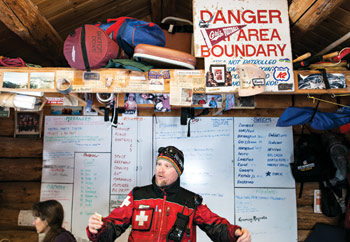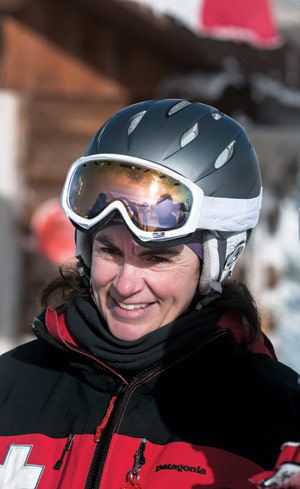WHITEFISH – On a gray winter day atop Big Mountain, Lyle Rutherford was skiing alone when something went terribly wrong. One of his skis caught an edge in the crusty snow and suddenly he began tumbling head-over-heels down the slope.
As Rutherford bounced down the hill he heard a violent crack. It wasn’t his ski that had snapped, but his leg. Unfortunately this was 1939, before the aid of ski patrol was available. The only way for Rutherford to get down the mountain was to ski on one leg, occasionally stopping to throw snow on his face to keep from passing out.
Rutherford’s mishap – the first serious ski-related injury reported on Big Mountain, according to Jean Arthur’s book “Hellroaring” – happened nearly a decade before an organized ski patrol even existed on the hill and two decades before a full-time patrol was established in 1960.
Today’s Whitefish Mountain Resort ski patrol is based out of a cramped log cabin on the summit of Big Mountain. This elite group of skiers comes to the rescue of people like Rutherford every day, including when accidents turn tragic, such as in January, when a 54-year-old man from California died after falling in a tree well. Helping people in trouble is just one of its many jobs.
“When I started this job, I only knew 20 percent of what it entailed,” said Jeff “Butte” Soyland, an 18-season veteran of the patrol.
Back in the 1930s, when people first began flocking to Big Mountain’s slopes, skiers had to take care of each other in case of an emergency. It was not until after World War II that a volunteer patrol was organized. By the 1950s, the patrol was outfitted with a shack and some toboggans to help rescue injured skiers. Besides bringing people to safety, the ski patrol of the 1950s also had to groom the slope by side-stepping the hill.
In 1960, when Chair 1 to the summit was built, five skiers made up the first full-time, professional patrol on Big Mountain. In 1975, Terri Rolseth Montgomery became the first woman to join the patrol. Although some were skeptical of her inclusion on the crew, she soon proved her worth on the slopes. Today, nearly half of the Whitefish Mountain Resort patrol is female, well above the national average of 20 percent.
Twenty-four patrollers and two dispatchers make up the Whitefish Mountain Resort ski patrol, “the first responders of Big Mountain,” said spokesperson Riley Polumbus. The patrollers are employees of the resort. There is also a Big Mountain Ski Patrol Inc., a nonprofit group run by the patrol to promote safety and education. The patrol is based on the summit because it’s the one spot on Big Mountain where any run or location can be quickly accessed. There is also a Base Lodge Health Clinic operated by North Valley Hospital that can perform X-rays and diagnose minor injuries.
This season, the patrol added two new spots and another patroller will likely be added next year with the opening of the Flower Point lift. Joining the coveted ranks of the ski patrol is no easy task.
 |
|
Jeff “Butte” Soyland describes the process of end-of-the-day sweeps by the ski patrol at Whitefish Mountain Resort. – Greg Lindstrom | Flathead Beacon |
“It’s a great job and you don’t want to leave it,” said Kellsey Perkins, who has been on the patrol for 14 years. “A lot of us worked different jobs on the mountain before coming to the ski patrol because it’s a great job and no one gives it up.”
Prior to joining the patrol, Perkins worked in the events department. Soyland, the 18-year veteran, drove a bus on the mountain after college in the 1990s and “as the old story goes, one winter in Whitefish turned into two winters.” Each patroller must have 120 hours of training before being certified by the National Ski Patrol and they also take refresher courses at the beginning of the season. Every patroller has outdoor emergency care training.
Although snowboarders can also be on the patrol, most members prefer to ski because it’s easier to drag a loaded toboggan that way. While the patrol have snowmobiles at their disposal, most of the time it’s more efficient to respond on skis. Ten to 12 patrollers work every day, with additional patrollers filling out the roster on busy holidays or weekends, when upwards of 7,000 skiers can converge on the hill. Patrollers usually work four day shifts and one night shift a week. A dispatcher also works out of the summit patrol house and acts as a “quarterback” coordinating rescue efforts and organizing patrollers. Whenever there are skiers on the mountain, patrollers are nearby.
“We’re the first ones up and the last ones down,” Perkins said.
At 6:30 a.m., hours before the first skiers arrive in line at Chair 1, a patrol member fires up a snowmobile and heads up the mountain. Soyland said that early arrival is the first of many perks of being on the patrol, especially on a clear morning, and he has documented proof on the photo album on his phone.
“I still get goosebumps when I see a sunrise up here on a clear day,” he said, scrolling through photos. “It’s pretty neat to be up here and be alone. I always think ‘how lucky am I?’”
The first patrollers to the hill strap on their skis and head into the trees to check a snow depth marker and then open up the summit patrol shack. On some mornings they will get an early start on avalanche control, trying to trigger slides with their own skis or explosives in order to make the slopes safer for visitors.
At 8 a.m., the rest of the patrol meets at the base of the mountain for a morning briefing before heading to the summit. There, they will start a long list of daily chores, including putting out signage, ropes and “fog balls,” which are put out on the slopes when visibility is scarce to let people know where they’re going. They also check on nearly 300 tower pads, which are wrapped around lift towers just in case a skier loses control and hits one. All the duties are listed on a marker board inside the summit house and as the day goes on, each task is checked off, although tasks are forever persistent.
 |
|
The ski patrol flag blows in the wind at the summit at Whitefish Mountain Resort. – Greg Lindstrom | Flathead Beacon |
Two or three patrollers are stationed on the summit at all times, while others go about the daily chores or go around educating skiers on how to be safe. If a patroller believes someone is being unsafe, like skiing too fast in a certain area, they can pull their pass. While the patrollers spend most of their days on skis, it’s not always a fun job.
“No run is necessarily a fun run because you’re always on the job and keeping an eye out for problems,” Soyland said.
“And it’s not always powder skiing,” Perkins said. “We’re up here every day and the conditions are not always great.”
But the patrol’s primary mission is to help skiers and riders in need. Some days are busier than others, but there is always a demand. According to the National Ski Areas Association, during the past decade, 41.5 people have died each year in skiing and snowboarding accidents. During the 2011-2012 ski season, 54 people were killed out of 51 million skier/snowboarder visits reported.
When a call comes in, the dispatcher at the summit will take down the information about where the incident has happened and what type of injuries have been sustained before sending a patroller. A normal response time is under five minutes. A patroller will usually tow a toboggan with basic supplies and later report back to the summit if they need more help or supplies. The best report is a detailed one, and Polumbus said skiers and riders should always try and remember the name of the run they are on.
Once on scene, and if the injury warrants special treatment, the patrollers’ job is to stabilize the patient and transport them to help. In some cases, patrollers will take them to the clinic at the base of the mountain. In other, more extreme cases, they take them directly to an ambulance or a waiting helicopter; “these guys are the ambulance to the ambulance,” Polumbus said.
One call Soyland will never forget came on March 22, 2001, when professional skier Bill Johnson crashed on a training run at Big Mountain, while he was trying to make a comeback and earn a spot in the 2002 Winter Olympics. Johnson gained stardom in 1984 when he won a gold medal in downhill racing.
On a warm-up run at the U.S. Alpine nationals, Johnson lost control and crashed through four fences, suffering severe head trauma. Soyland was one of the first people to get to Johnson after the crash and he said the skier’s tongue was halfway down his throat and blocking his airway.
 |
|
Kellsey Perkins, a member of the ski patrol at Whitefish Mountain Resort. Greg Lindstrom | Flathead Beacon |
“He had a pulse and was able to breathe, but we got him to the A.L.E.R.T. helicopter fast,” Soyland said. “It was a spectacular, high-speed crash and your average skier would not have survived.”
Johnson was in a coma for three weeks and he had to relearn how to walk, talk and eat again.
But ski wrecks are not the only emergencies the patrol responds to. Each lift on Big Mountain has a detailed evacuation plan if it shuts down and the back-up motors cannot be started. If visitors are stuck on the lift, the patrol will throw ropes up to each chair and use a harness to lower everyone to the ground. In perfect conditions, an evacuation of Chair 1 would take over two hours.
“In my time here, we’ve only done two lift evacuations,” Soyland said. “Knock on wood.”
But not every day on the mountain is high stress and the patrollers have an endless number of stories to tell around the bar at The Bierstube. Perkins said one of the weirdest incidents happened last season, when the patrol found an entire set of clothing on a run. No one ever figured out who had stripped down to the buff but the clothing was stored in the summit building for the rest of the year.
As Perkins and Soyland tossed stories back and forth at the summit, they remembered an incident a few days earlier in which they stopped a novice skier from going down the hill with her skis on backwards.
At the end of each day, the patrollers gather at the summit cabin and discuss the day’s events. After, they do a sweep of each side of the mountain, yelling “last call!” to make sure everyone heads home. The sweep provides one more run for the patrol’s dedicated members, and a reminder of why they enjoy their job so much.
“I love it,” Perkins said. “It’s a great and supportive group of people who want to help people … There is something really special about this hill.”